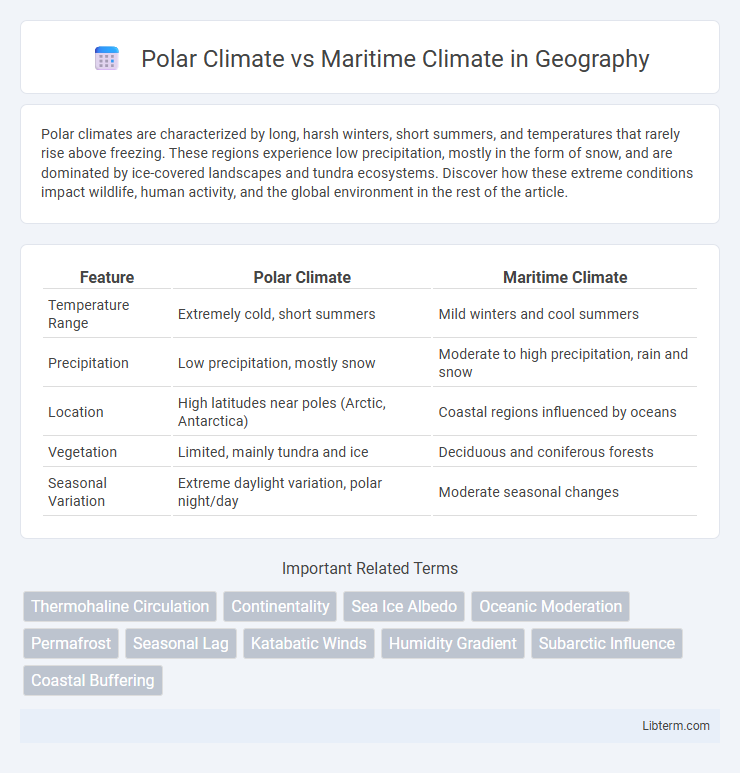Polar climates are characterized by long, harsh winters, short summers, and temperatures that rarely rise above freezing. These regions experience low precipitation, mostly in the form of snow, and are dominated by ice-covered landscapes and tundra ecosystems. Discover how these extreme conditions impact wildlife, human activity, and the global environment in the rest of the article.
Table of Comparison
| Feature | Polar Climate | Maritime Climate |
|---|---|---|
| Temperature Range | Extremely cold, short summers | Mild winters and cool summers |
| Precipitation | Low precipitation, mostly snow | Moderate to high precipitation, rain and snow |
| Location | High latitudes near poles (Arctic, Antarctica) | Coastal regions influenced by oceans |
| Vegetation | Limited, mainly tundra and ice | Deciduous and coniferous forests |
| Seasonal Variation | Extreme daylight variation, polar night/day | Moderate seasonal changes |
Introduction to Polar and Maritime Climates
Polar climates are characterized by extremely low temperatures, minimal precipitation, and long, harsh winters with brief, cool summers, primarily found in the Arctic and Antarctic regions. Maritime climates experience moderate temperatures year-round due to the proximity to large bodies of water, resulting in high humidity, mild winters, and cool summers, typical of coastal areas like Western Europe and the Pacific Northwest. These distinct climate types influence local ecosystems, weather patterns, and human activities through their unique temperature ranges and moisture availability.
Geographic Distribution of Polar and Maritime Climates
Polar climates dominate high-latitude regions near the Arctic and Antarctic Circles, characterized by extreme cold and long, harsh winters, primarily found in parts of Greenland, Siberia, and Antarctica. Maritime climates are typically located along western coastlines between 40deg and 60deg latitudes, such as in Western Europe, the Pacific Northwest of the United States, and parts of New Zealand, where oceanic influences moderate temperatures. The geographic distribution reflects the strong influence of ocean currents and continental placement, with polar climates inland or near polar ice caps, and maritime climates influenced by prevailing westerly winds and proximity to the sea.
Key Climate Characteristics: Polar vs Maritime
Polar climates feature long, harsh winters with temperatures often plummeting below -30degC and short, cool summers rarely exceeding 10degC. Maritime climates exhibit mild winters and cool summers, with temperature ranges typically between 0degC and 20degC due to the moderating influence of nearby oceans. Precipitation in polar regions is low and primarily falls as snow, whereas maritime climates experience higher humidity and more consistent rainfall throughout the year.
Temperature Range Comparison
Polar climates exhibit extreme temperature ranges, often fluctuating between -40degC in winter and just above 0degC during summer months due to limited solar radiation and prolonged darkness. Maritime climates maintain narrower temperature ranges, generally between 0degC and 20degC, influenced by the moderating effects of nearby oceans which reduce seasonal temperature extremes. The difference in temperature variability is primarily driven by the distinct geographic and atmospheric conditions affecting heat retention and distribution in each climate type.
Seasonal Variation in Polar and Maritime Regions
Seasonal variation in polar climates is extreme, with long, harsh winters and brief, cool summers due to limited solar radiation and ice-albedo feedback effects. Maritime climates experience moderate seasonal changes, characterized by mild winters and cool summers influenced by the thermal stability of nearby oceans. Temperature fluctuations in maritime regions are less pronounced than in polar zones, where seasonal contrasts are driven by prolonged periods of darkness and daylight.
Precipitation Patterns and Differences
Polar climates experience low annual precipitation, primarily as snow, due to cold air holding less moisture, resulting in dry conditions despite often heavy snowfall during specific seasons. Maritime climates, influenced by proximity to oceans, receive higher and more evenly distributed precipitation throughout the year, mostly as rain, due to moist air masses and frequent weather systems. The stark difference lies in the quantity and form of precipitation: sparse, snow-dominated in polar regions versus abundant, rain-dominated in maritime zones.
Influence of Ocean Currents
Ocean currents significantly shape both polar and maritime climates by regulating temperature and moisture levels. In polar climates, cold ocean currents contribute to extreme cold and ice formation, reinforcing frigid conditions and limited precipitation. Conversely, maritime climates benefit from warm currents that moderate temperatures, increase humidity, and promote milder winters and cooler summers along coastal regions.
Flora and Fauna Adaptations
Flora and fauna in polar climates exhibit extreme adaptations such as antifreeze proteins, thick insulating fur, and slow metabolic rates to endure prolonged freezing temperatures and limited sunlight. In maritime climates, diverse plant species benefit from mild, moist conditions, leading to lush forests and abundant marine life with adaptations like salt tolerance and seasonal breeding cycles. These contrasting environments drive specialized ecosystems, where polar species prioritize survival under harsh cold, while maritime species exploit stable climates for growth and reproduction.
Human Activities and Settlements
Human activities in polar climates are limited due to extreme cold, permafrost, and short growing seasons, resulting in sparse settlements primarily oriented around scientific research and resource extraction such as mining and oil drilling. Maritime climates, characterized by milder temperatures and higher precipitation, support denser human settlements with diverse economic activities including agriculture, fishing, and tourism. Infrastructure in maritime regions adapts to wet conditions and fluctuating temperatures, whereas in polar areas it requires insulation and protection from harsh weather to sustain limited populations.
Climate Change Impact on Polar and Maritime Areas
Polar climates experience accelerated warming due to climate change, resulting in rapid ice melt and permafrost thaw that drastically alter ecosystems and contribute to global sea-level rise. Maritime climates, influenced by proximity to oceans, face rising sea surface temperatures and increased storm intensity, impacting coastal habitats and human settlements. Both regions are critical indicators of climate change effects, with polar areas acting as sensitive early warning systems and maritime zones facing intensified weather patterns and ecosystem shifts.
Polar Climate Infographic

 libterm.com
libterm.com